The concept of modularity, although gaining traction in today’s building trends, has actually been around for years, being the backbone of major chains like Cosmos, Celestia, and even KYVE!
But what really is a modular chain, how is modular different, what is its role in the Web3 space, and its impact on the future?
Let’s get this course started…
Fundamentals of Modularity in Blockchain
Think of technology like a toy train set. At first, it was like one big train where everything was connected. In more technical terms, this is called monolithic architecture. If you need to change something, it affects everything else, similar to changing the entire train set when one part has a problem.
For blockchain development, monolithic architecture creates a lot of roadblocks, especially regarding the blockchain trilemma:
The blockchain trilemma involves achieving a delicate balance between three major components for a successful blockchain: decentralization, security, and scalability. Monolithic chains struggle to maintain this equilibrium due to the complexity of this trilemma, wherein a single, all-encompassing structure handles consensus, smart contracts, and data storage. These chains focus on everything and nothing at the same time, making it difficult to provide high-quality solutions for each of their problems.
Plus, achieving scalability becomes cumbersome as the entire network has to be upgraded as a whole, making it difficult to adapt to growing demands efficiently.
In 2018, a new concept arose via a paper by Mustafa Albasan and Vitalik Buterin called “Data Availability Sampling and Fraud Proofs.” Instead of having one big train, they introduced the idea of having multiple small train cars that link together, AKA modular architecture. In this sense, you can change a train car out without messing up the others.
For blockchains, this meant scalability didn’t compromise security or decentralization since not every user (AKA full node or archival node) had to store and process the entire blockchain, and each function could be managed independently by specialized teams. Overall, breaking through the blockchain trilemma.
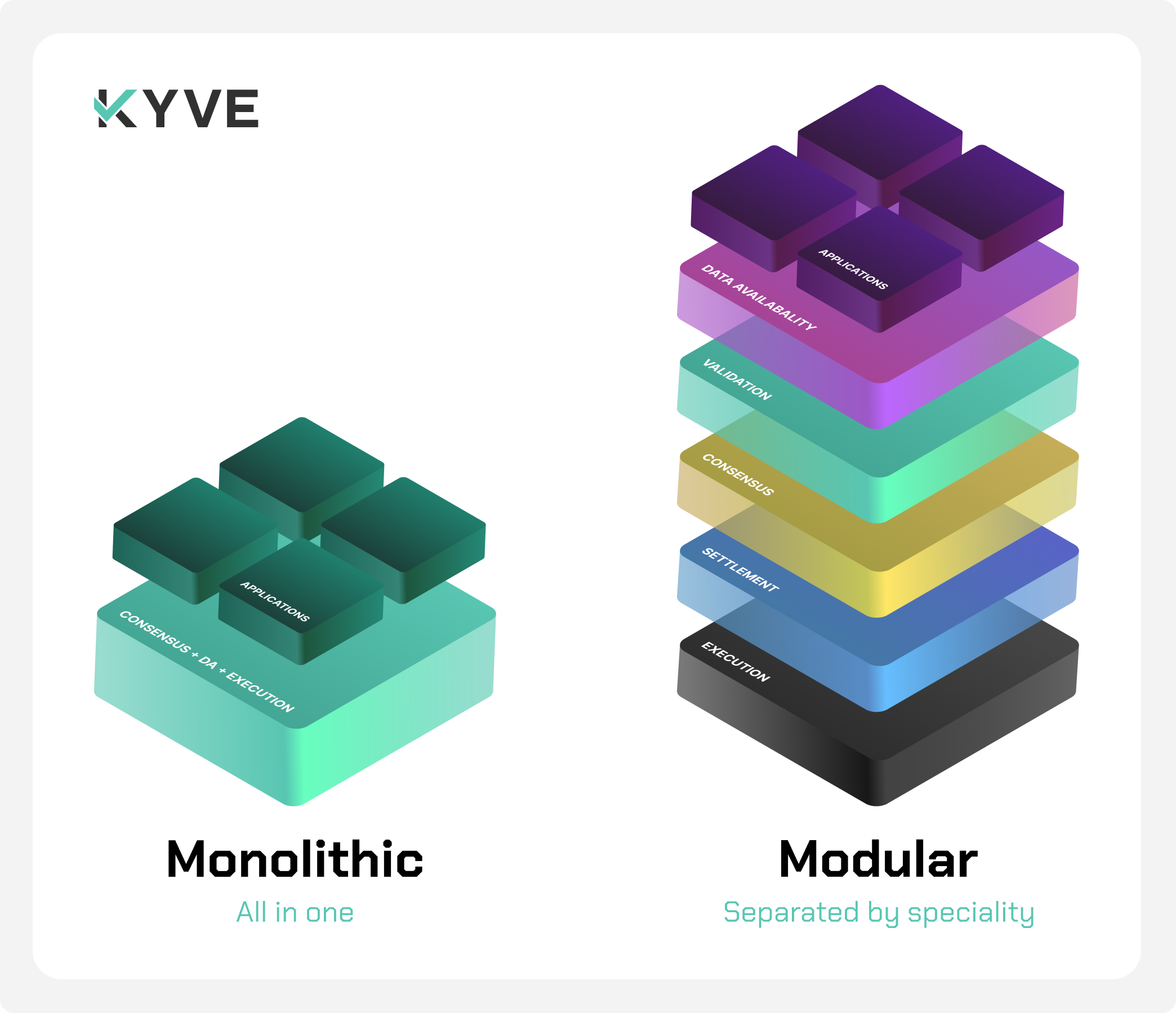
This concept led to the development of the first modular chains like Cosmos Hub and Celestia. Cosmos Hub, for example, allows different blockchains to work separately yet connect through a central hub, much like separate train cars linking together.
Modular Architecture Explained
In the context of modular blockchain architecture, the system is often divided into distinct layers, each with its specific function:
- Execution Layer (VM Layer): Here, the actual processing of transactions takes place. This includes the execution of smart contracts, the validation of transaction rules, and the updating of the blockchain’s state. This layer is where the business logic of the blockchain is implemented, and it’s crucial for maintaining the trustless nature of the system.
- Settlement Layer: This is the layer where the finality of transactions is established. It serves as the record-keeping layer, analogous to a ledger in traditional accounting. It provides a permanent, immutable record of all transactions that have been validated and agreed upon by the network.
- Consensus Layer: This layer is tasked with achieving agreement among the network’s participants about the current state of the ledger. It ensures that all nodes in the blockchain are synchronized and agree on the validity of transactions. Different blockchain implementations might use various consensus mechanisms like Proof of Work (PoW), Proof of Stake (PoS), or others in this layer.
- Data Availability Sampling (DAS) Layer: This layer is responsible for the storage and dissemination of data. It ensures that all the necessary data required to validate blockchain transactions is readily available to all participants in the network. The DAS Layer’s primary focus is on the reliability of data storage for a limited period of time (30 days in Celestia’s case) and the transparency of data access.
Other layers include:
- Data Validation Layer: To ensure reliable data integrity from the start, blockchains need a data validation layer like KYVE, which fetches, validates, and permanently stores historical data from chains, making it a streamlined public good for the ecosystem to leverage (just like a decentralized archival node).
- Interoperability Layer: In some modular blockchain architectures, there’s an additional layer dedicated to enabling the blockchain to interact and integrate with other blockchains and external systems. This layer is crucial for cross-chain transactions and broader blockchain applications.
- Application Layer: This is the topmost layer where applications built on the blockchain operate. It interfaces with end-users and utilizes the underlying blockchain infrastructure to offer various decentralized applications (DApps).
Together, these layers form the backbone of a modular blockchain system, each with a distinct yet interconnected role, ensuring the blockchain’s functionality, security, and integrity.
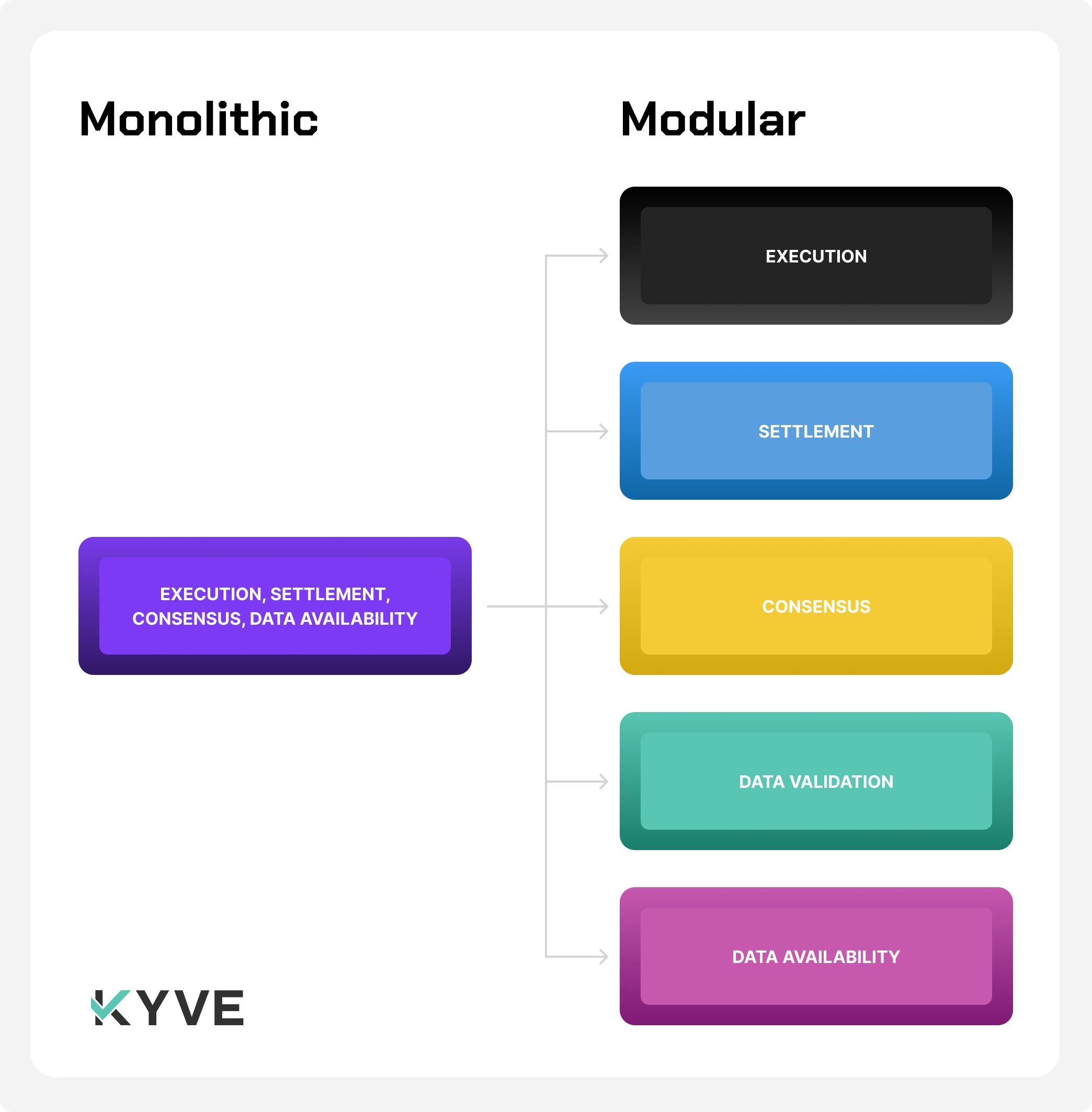
Chains in the Web3 Ecosystem
Role of Modular Chains in Web3: Scalability & Efficiency
With Web3 leading the way for the next generation of the internet, bringing on decentralization and faster building opportunities, modular chains are an easy next step in the course of its evolution, overall enhancing scalability and efficiency.
In a modular system, each major function of a chain or ecosystem architecture is split up and put into the hands of specilialized chains solely focused on solving that specific function. In doing so, it heavily promotes standardization of communication between chains, code reusability, and overall collaboration for the betterment of Web3.
This also means that when building your own blockchain, you can go modular and simply assemble the modular chains that your concept needs so that you can focus on building the exact part that makes your solution so special!
Real-World Applications
Modular chains are not just theory; they’re already in use. For example, Cosmos Hub, KYVE, and Celestia, as mentioned in the previous chapter.
Other blockchains are also shifting towards modularity, such as:
- Polkadot: It allows different blockchains to connect and work together. It’s used in finance for cross-chain transactions.
- Ethereum 2.0: It aims to separate data and processing layers to improve efficiency.
- Avalanche: It offers high transaction output at a lower cost, beneficial for financial services and decentralized finance (DeFi) applications.
Impact on Web2 Industries
Modular chains are aiming to impact many industries, not just in Web3. In finance, they can make transactions faster and cheaper. In healthcare, they can securely manage patient data across different systems. Modularity is also being exploried for uses in areas like supply chain management, where tracking and verifying products can be thoroughly improved.
Challenges and Potential Solutions
Every new technology faces hurdles. For modular blockchains, one challenge is ensuring security across different modules. Another is keeping the system efficient as it grows, especially regarding the interoperable. Solutions currently being explored for these include advanced cryptographic methods for security, new algorithms for better scalability, and even KYVE!
Deep Dive into KYVE – A Modular Chain For Data Validation
The idea for KYVE came about in early 2021 from co-founders Fabian and John participating in a bounty to bridge Polkadot data to Arweave, a permanent data storage solution. After building the necessary tool, they realized that if it were more decentralized and built out, it could apply to other blockchains and, in turn, aid historical data validation and management for all in Web3.
The Cosmos SDK was the perfect base for building KYVE. By easily customising already existing modules, it was possible to focus heavily on building out the validation protocol itself. You can imagine KYVE as a middleware that sits in between a data source and data storage or availability layers like Arweave, ensuring that all data that developers build with is truly correct.
The protocol is made up of data pools, each pertaining to a specific data set, like Cosmos Hub blocks. Each data pool has up to 50 validators, one of which is randomly selected to fetch the bundle (batch of blocks) from chains like Cosmos Hub, and upload it onto data storage or availability platforms like Arweave. From there, the other validators cross-verify if the bundle matches what they fetched as well from a different data source. If the validators reach quorum with the majority saying that the data is correct, then that bundle is deemed valid and kept track of by KYVE’s data lake for anyone to source from.
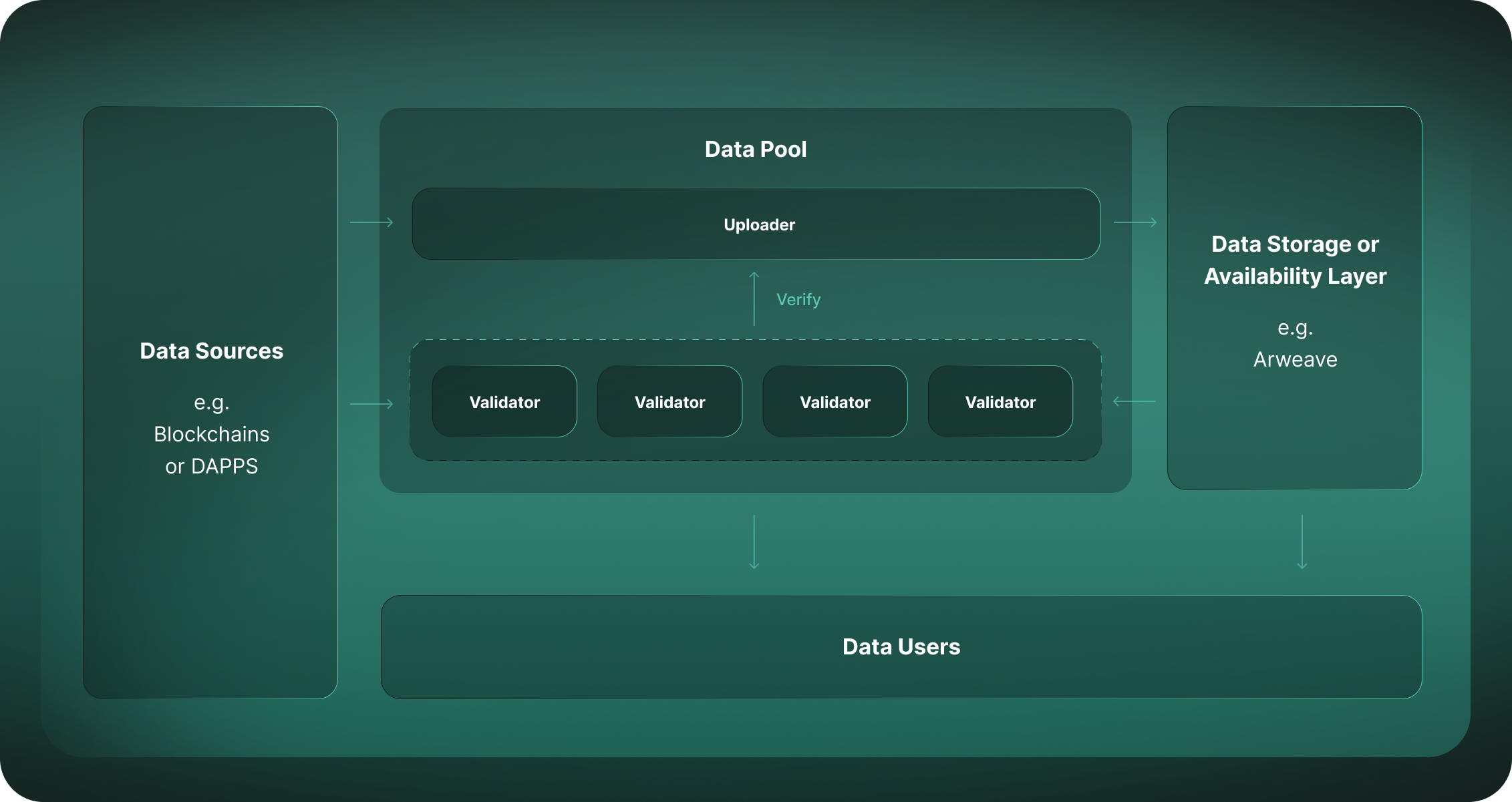
After launching its mainnet in March 2023, KYVE has been providing its trustless data validation protocol for chains like Cosmos Hub, Cronos, Osmosis, Axelar, and Archway. With KYVE being modular, it can easily be plugged into other PoS chains, like Polkadot, Avalanche, Ethereum, and others to ensure a trustless backup of their historical data. As KYVE archives and validates other blockchains from Genesis, more historical data is being made available to the public, making Web3 data a trustless, public good.
KYVE also contributes to modular innovation by ensuring that the actual connection between modular chains is made trustless. If you go modular, it’s key that the traffic between the modules is secure and streamlined in a decentralized way. Like how the internet has a seamless connection to computers, KYVE can validate all the data traffic between modular chains in a trustless way.
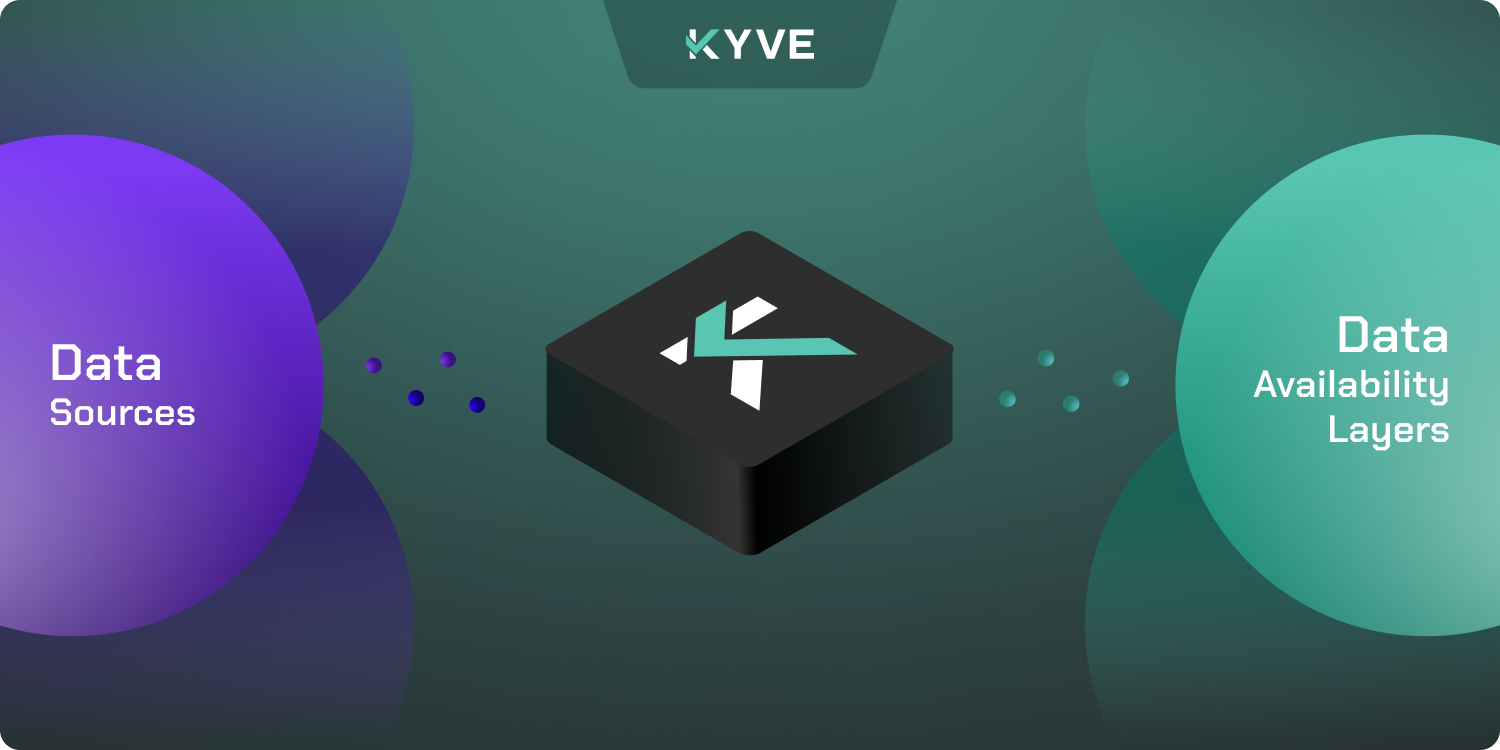
The Future of Modularity in Web3
Although brought to light in 2018, modular chains are taking a strong stance in the top 2024 Web3 trends, inspiring new innovations and ecosystems.
The shift towards a modular approach marks a significant evolution in blockchain technology. Steering away from monolithic structures, the modular architecture introduces enhanced flexibility, scalability, and security. Ultimately providing solutions for the blockchain trilemma and increasing overall opportunity for lasting innovation.
Developers are already working on making modular chains even more efficient, secure, and builder-friendly, and even adapting already established chains to fit this new structure. For example, KYVE aiding modular scalability and ensuring the decentralization of historical data from the Genesis of a chain.
It’s safe to say, the future of modular blockchains in Web3 looks bright.
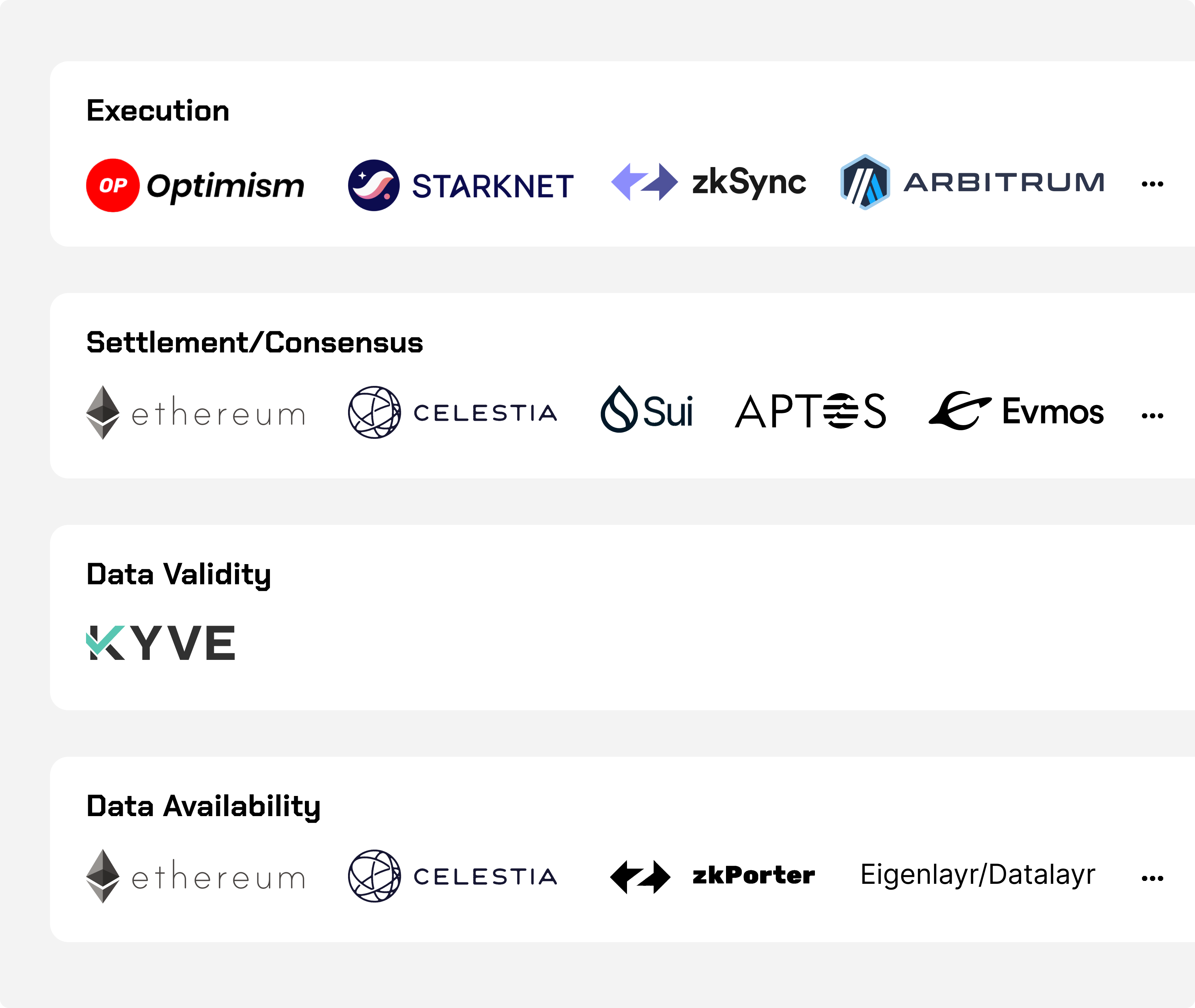
Conclusion
Congratulations! You made it through the Modular Beginner course! You are now caught up on the general concept of modular chains in Web3 and KYVE’s role in its innovation. In due time, more advanced courses on modular chains and their unique architecture will be added to further your learning journey on the topic, stay tuned!
Want to learn more? Feel free to check these resources:
This course was co-written with The Rollup
The Rollup is an educational hub acting as a public good that has addressed the need for reliable and accessible information in the rapidly evolving world of DeFi. With 4 years of experience in crypto education, attending conferences, and producing content The Rollup team is well-versed in creating foolproof education and doing deep dives with technical and non-technical builders.
